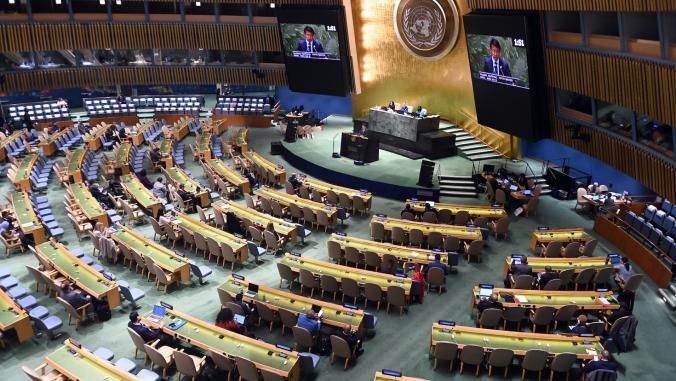What innovation looks like when water is a strategic resource
Learning from Israel's leadership.

Practitioners in the water sector are familiar with the statistics on water management in Israel. An estimated 90 percent of the wastewater generated there is reused, making it the global leader in this practice. For comparison, Spain is second at about 20 percent reuse; the United States reuses about 1 percent of its water. In addition to water reuse, Israel supplies about two-thirds of its domestic water from desalination.
These are impressive statistics. However, there is much more to the story.
A few weeks ago I was fortunate to attend WATEC, the showcase for Israeli water technology innovation. (I thank Elad Frenkel, chairman of WATEC 2017 and CEO of Aqwise, and Oded Distel, director of Israel NewTech, Ministry of Economy and Industry, for the invitation and my active role in the event.)
One key attribute of wicked problems is that they rarely sit conveniently within the responsibility of any one organization .
I presented during the CleanVest summit on "Digital Water" innovation; took part in the "Value of Water and an Abundance Strategy," an OECD roundtable discussion on financing water; and joined a Global WaterWorks session on water technology go-to-market strategies. I mention these activities because it highlights the diversity of the discussions at WATEC. This was not merely a trade show. Instead, this gathering highlighted key water issues, as well as technology and non-technology solutions.
My takeaways from the conference:
- We need to think about water security more holistically — This is not just about cybersecurity and the various technology solutions for addressing it. Globally, there is an increased focus on water security as a water management strategy, with an emphasis on emergency preparedness and response. While I was in Israel, I had the good fortune to speak with Danny Lacker, head of Water Security and Emergency Division, State of Israel Water Authority, who gave me a tour of his exhibit to explain how he and his team ensure that the country is prepared for disruptions in water supplies and can respond quickly. In view of incidents such as the crisis in Flint, Michigan, and the impacts of extreme weather events in Florida and Texas, the United States would benefit from an Israeli approach to water security: Be prepared.
- The role of digital technologies is becoming more vital — I am convinced that digital technology applications will disrupt and transform the water sector. WATEC highlighted several Israeli digital technology solutions such as those developed by Kando, which markets smart wastewater solutions; SIGA Scada Cyber Alert Systems, which sells notification technology for mission-critical infrastructure; and Lishtot Water Quality Testing Technology, which makes systems for tracking potential contamination. These are just a few companies representing a diverse set of digital solutions for managing water, security and water quality testing. What these companies are addressing is the need to proactively understand wastewater quality and sources of pollution (Kando), how to handle cyber threats and attacks (SIGA) and ways of monitoring and disclosing drinking water quality (Lishtot). I found Lishtot to be particularly interesting in that its technology provides a consumer with the ability to know if the water they are about to drink is "safe." Imagine, real-time and democratized access to water quality information — I will be tracking the progress of Lishtot and all of these companies.
- Remember the importance of winning over business ecosystems — While WATEC was clearly technology-focused, there were sessions that covered the need for innovative stakeholder ecosystems to address the "wicked problems" of water. One key attribute of wicked problems is that they rarely sit conveniently within the responsibility of any one organization and as a result solutions require an ecosystem of stakeholders to solve. The Global WaterWorks session, for example, tackled a range of water issues such as building technologies, quality and security. The key theme was how to mobilize stakeholders to adopt innovative technology solutions and innovative non-technology strategies such as business models and financing. My key takeaway from this session is that while an individual technology looks like a great solution, it can only scale though engagement with a group of stakeholders that support overcoming the initial barrier technology adoption and scaling solutions. Elegant technology solutions are not enough.
- Public sector innovation matters — Yes, public sector innovation. The Porter School of Environmental Studies at Tel Aviv University and the American Water Resources Association (AWRA) co-hosted a two-day dialogue on "how water managers, engineers, scientists and policy makers are working together to develop and implement solutions to address some of the world’s most pressing water challenges." The theme was "Cutting-edge Solutions to Wicked Water Problems," and the session engaged both public and private sector sectors on how to address the complex challenges of water risks and security. For example, how could California scale wastewater reuse and desalination technologies, what are the public policy barriers and what are the incentives to scale adoption? (Thank you to Sharan B. Megdal, from University of Arizona, and Felicia Marcus from the California State Water Resources Control Board for introducing me to this special event and follow-up discussions.)
The bottom line for me is that when water is acknowledged as a strategic resource it drives innovation and can create a robust technology export business. It also moves stakeholders beyond the usual discussion of water risks and moves to a "bias for action" public and private sector water strategy.





